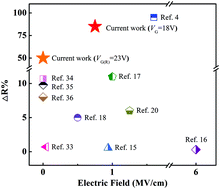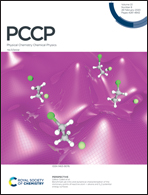Nonvolatile ferroelectric field effect transistor based on a vanadium dioxide nanowire with large on- and off-field resistance switching†
Abstract
We fabricate a ferroelectric field effect transistor (FeFET) based on a semiconducting vanadium dioxide (VO2) nanowire (NW), and we investigate its electron transport characteristics modulated by the ferroelectric effects. The transistor consists of a single VO2 NW as the channel and a ferroelectric Pb(Zr0.52Ti0.48)O3 (PZT) thin film as the dielectric gate. The conductance of the VO2 NW channel is found to be feasibly modulated by the ferroelectric gate with an 85% resistance change under the gate voltage of 18 V (at an applied field of about 0.75 MV cm−1). The electron transport property of the device can be controlled by the remnant polarization of the PZT layer due to the nonvolatile property of the ferroelectric gate, with an off-field change of channel resistance up to 50%. Moreover, multiple resistive states can be achieved by sweeping gate voltage across the device appropriately. These results demonstrate that ferroelectric gate modulation is an efficient tool to regulate the electron transport properties of the VO2 NW, and the VO2-NW-FeFET has potential applications in nonvolatile and low-power consumption devices.



 Please wait while we load your content...
Please wait while we load your content...